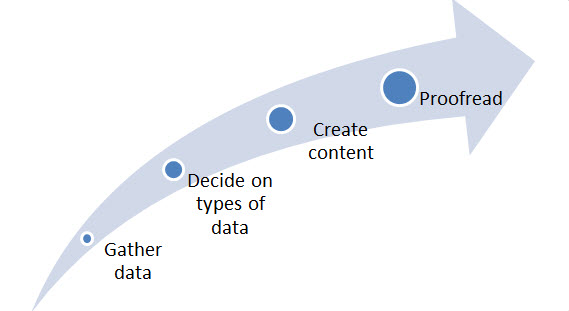 As a store owner, have you ever carried out a content marketing strategy? If yes, how do you carry out it? If no, let’s think again. Whether you realize or not, your company has already used content marketing at least one time. It is revealed that interesting content is a top 3 reason why people follow brands on social media (Content Plus, 2011). Moreover, according to Custom Content Council (2012), 61% of consumers say they feel better about and are more likely to buy from a company that delivers custom content.
As a store owner, have you ever carried out a content marketing strategy? If yes, how do you carry out it? If no, let’s think again. Whether you realize or not, your company has already used content marketing at least one time. It is revealed that interesting content is a top 3 reason why people follow brands on social media (Content Plus, 2011). Moreover, according to Custom Content Council (2012), 61% of consumers say they feel better about and are more likely to buy from a company that delivers custom content.
What is content marketing
There is no exact definition of content marketing. In general, content marketing is understood to provide valuable information or content to actual and potential customers for the purpose of building trust, branding, awareness, and positive sentiment. It can be visual, auditory or written.
Content marketing exists in many types, the following are just types that regularly used to build a content marketing strategy:
- Guest blog posts
- E-books
- Email newsletters
- PowerPoint presentations
- Podcasts
- Standard videos
- Micro-videos (i.e., Vine)
- Social media posts
- Live presentations
- Webinars
- White papers
- Blog posts
Why should implement content marketing
To attract customers and keep their loyalty
Content marketing plays role in attracting customers and keeping readers’ attention, this is proved by TMG Custom Media (2013) through stating that 90% of consumers find custom content useful and 70% of them feel closer to a company after reading content (Content Marketing Institute, 2012).
Moreover, the final goal of any marketing strategy is to improve the efficiency of business. Content marketing allows you to increase direct sales as 60% people inspired seek out a product after reading content about it (Content Plus, 2011).
To lower cost and increase visibility
Content marketing allows you to reduce cost and raise your sites rank in search engines. If you carry out content marketing, you can reduce 62% cost in comparison with traditional marketing (Demand Metric, 2013).
For per dollar spent, content marketing can create three times as many leads as traditional marketing. And it helps your sites rank well in search engines, too. Google’s recent Penguin algorithm updates have forced many business owners to take a look at their content strategy and link portfolios. Sites with unsavory linking practices, sub-par content, and no social media signals, are losing visibility in Google’s search rankings.
How to build a content marketing strategy
Set objectives
Before setting objectives for a content marketing strategy, you should review the mission of your company because in each strategy the company turns its mission into detailed supporting objectives.
Though you have very far different goals for each strategy and for each company such as increasing number of Facebook “Likes”, growing database of email addresses, raising 10% sales, acquiring new customers, increasing website traffic, and so on, always keep in mind SMART rule. In other words, you need to establish a Specific, Measurable, Achievable, Realistic, and Timely goal.

This step has a common mistake: Some marketers tempt to analyze the direct influence of content to sales and make this one of your key performance indicators. In reality, your content efforts probably will not function this way. Instead, decide on goals that will align with your other marketing strategies, such as improving your social media presence or harvesting email addresses for future email marketing campaigns.
Understand buyers
This step is equivalent to the second “W” letter in 5W of drawing a marketing idea: Who is the audience for you content?
Customer purchases are influenced strongly by a wide range of factors. For the most part, marketers cannot control such factors but they must take them into account. A solution which has been applied by many marketers to know exactly your audience is to get a portfolio of persona profiles.
Content of a persona profile has the following items:
- Title
- Time in the job
- Works directly with
- Daily tasks
- Responsibilities
- Likes/dislikes about job
- Frustrations
- Pressures
- Concerns
- Needs
- Role in buying process
- Buying stage
- Drivers
A tip for you is to add images and give name of buyer, so that both you and your colleagues will think of a real person instead of just a mass of paper.
In a previous article, I mentioned a four-step process to understand your target customers, it is helpful for you to take a look at this.
Build content
Gather data
In terms of gathering data, there are two ways: Collecting primary data and gathering secondary data.
If you decide to collect your own data (primary data), you may want to use services, Survey Monkey for example, which are helpful for creating and delivering questionnaires. They can also be placed onto a page on your website, and you can use incentives such as discount codes to encourage site visitors to fill them in.
If you choose to repurpose an existing idea into a new format (secondary data), look for independent industry authorities who are known for collecting relevant information.
Decide on types of content
Once you have your data, you are free to create your content in any way you like. You are not restricted to one piece of content either, as you can create a wide range of content depending on what you are looking to do with it.
Create content
Next, you create content basing on your data and purposes. Your content should be concise and clear; rule is to state the most important data first. You can also use quality images to illustrate your content, but be careful with email marketing because some email providers hides images in emails. Here is helpful information you should pay attention to.
Proofread
After you have finished creating content, make following checklist:
- Grammatical and vocabulary errors
- SEO: meta descriptions, keywords density, tags
- Writing style
- Consistency in your content
Organize distribution
Now you have a content marketing strategy that is already to be public. So the next thing to do is choose the right channels for marketing your content.
Let’s begin with finding out where your customers are on the Internet and what key words they often search for.

Once your customers get your content, encourage them share on their own social media channels. To facilitate social sharing, your content should meet the following requirements:
- To be interesting and useful
- To be simply and short (60-80 characters for a Facebook post)
- To lead customers to an action
- To leave a link of your website, but surely link is available to click.
Measure return on investment
Reviewing what you have done and the result of it plays a very important role in a content marketing strategy because it allows you to analyze and improve the quality of other strategies later.
In this final step, you need to:
- Keep track of performance
- Monitor your program and engage with your audience
- Measure your programs and report on progress.
Your turn
What do you have in mind? Is it similar to or different from what you often do?
Leave a comment and share us your experience, we will appreciate it.





![6 Best Shopify Shipping Rate Apps [2025] shopify shipping rate](https://blog.magestore.com/wp-content/uploads/2025/03/shopify-shipping-rate-270x180.png)

1 Comment
Hi Bruce, good Day. Thanks for sharing such great content marketing strategies, all the points that you discussed in this article are perfectly applicable on both the website and blog. If you apply content marketing strategy in the right way, you can achieve the desired result for an online business.